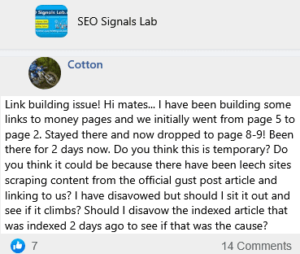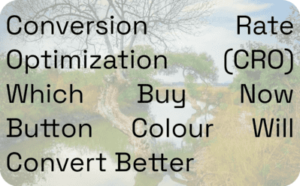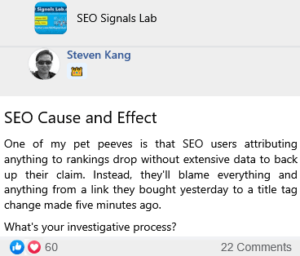Ammon
CTR is a thing
(but not the thing most think it is)
Click Through Rate (CTR) is a thing. Unfortunately it is a completely different thing to what Larry Kim (a guy who rose to fame only for paid search) thinks it is. It is also not the thing Rand Fishkin repeatedly claimed and failed to prove it was.
CTR never, ever, feeds back into the signal values of any particular site, page, or result. Instead, Click Through Rate (CTR) is a quality control metric to evaluate an entire Search Engine Result Page (SERP), and usually isn't even used at that level, but rather, used to assess the quality of an entire class or category of queries to see if a change gets users to satisfaction with less total clicks and time than previously.
CTR is used by Google in its machine learning algorithms to tweak an entire category of Search Engine Result Pages (SERPs). It feeds into the system Google use to identify "intent' to a query by how users interact with the SERP as a whole.
You know how different queries get treated differently, and how some will include a local pack and some will not, how some will get a knowledge panel, how some will get carousels? Google don't do this by hand. Google do this by testing, usually split-testing, and using CTR.
It goes a lot deeper than just whether or not someone includes words like 'near me' to determine when to include local results in some way, and to what extent. For example, if you search for most services that are usually provided only within a fixed radius such as plumbers, gardeners, plasterers, hairdressers, and millions more, the SERP is treated as a local search, because that's what performed best from Google's perspective, measured by CTR.
Sudden changes in either search volume, or CTR patterns, are used in another way too. They can tell Google that there may be some new context causing a shift in searcher intent.
This may be a new thing or breaking news – like how Hurricane Katrina suddenly changed the meaning of the word Katrina, and meant that searches for celebrities by that name was no longer necessarily the primary intent. Or how a sudden story about Prince William's latest child means searchers are slightly less likely to be looking for a discography by the artist Prince. Or like how someone searching for 'How Vaccines Work' a few weeks before Covid was a lot, lot more likely to be someone studying medicine or looking for broad medical information, but now is a lot more likely to be someone not broadly interested in medicine just wanting to know a bit more about one specific type of vaccine.
CTR is also how Google measure a lot of singular or recurring trends, including seasonality and other 'Temporal Web Dynamics' (the term professionals in Information Retrieval use to describe how time of day/week/month/season can affect intent, how burstiness and trends affect intent, etc).
If you'd like to see how IR scientists and actual search engineers look at such things, please do check out https://www.slideshare.net/…/temporal-web-dynamics-and… and give it a really thorough reading. (NB: This is something to put an hour or two aside for, not something you are probably going to get anything but wrongful assumptions from in just 10 minutes).
CTR doesn't change results, it changes the overall balance of signals used in a particular algorithm. A change to which may, instead of moving you a position or two up, knock you completely out of the new algorithms signal thresholds. Thankfully, as soon as the manipulation stops, the algo will generally swiftly return to its previous values, just like how once a trend stops trending, or a seasonal query passes that season, all other SERPs adapt.slideshare.net
Temporal Web Dynamics and its Application to Information Retrieval
WSDM2013 Tutorial on Temporal Web Dynamics and its Application to Information Retrieval
📰👈
29 👍🏽7 💟 19 💬🗨
And what if it doesnt stop? You realize that this document is from 2013 and far away from this very precize topic – SERP Click Through Rate (CTR)?
The document provides further reading on Temporal Web Dynamics, which is their term for how temporal factors (timing) affects both information itself, and the demand for information.
I linked to it because I'd just brought up that topic as yet another function of how Click Through Rate (CTR) is used, both in the short term and the longer term, and it is an effect you can see in use every single day once you understand it and know what you are looking for.
I'm sorry that my clearly identified link, described, and in context, confused you. I guess you skipped straight to the link without actually reading the context of the post it was in.
Chris Edwards 🎓 » Ammon
I remember us discussing the use of on mouse down scripting and measurement/recording by Google in the Search Engine Result Pages (SERPs), way back on the highrankings and Crea8 forums I think.
I also remember in one of the 'sat around the table' chats after an SEO strategies day, a Google guy stating that they 'rough test' the new algorithm based purely on the numeric score of the average onmousedown number for that search and that if the score went up, then the results displayed were bad.
A seriously uncomplex metric but in those days the algo was pretty basic really 🙂
I second the comment from Keith above, it's great to see you here 🙂
🤔1
Roger » Sabic
If you research this topic you will understand that most of the original research into CTR is from even earlier than 2013, closer to 2003. It shows how mature this area of study is.
It makes for a sad commentary on the SEO community that in 2021 we are still undoing the damage made by Moz and others who relied on sensationalist claims, bad correlations and populist falsehoods (zero click SERPs) to poison the community knowledge base.
Ree » Ammon
Thanks for sharing this. I have a couple of questions (I won't have the time to read the whole slide until end of Nov.)
1. Is it possible that Google has updated things since 2013 and now does use CTR's of individual SERP entries as an indicator of how relevant they are to a search query?
2. I've been chewing over the idea of testing different titles and metadata to see if I can improve the Click Through Rate (CTR) of some blog posts. Is there any reason not to do that since it may increase the chances of getting readers on our content?
To answer the first of those, while anything is *technically* possible, it is so incredibly unlikely that it may as well be impossible.
Long before 2013, Google patents and papers had spoken of why CTR was such an incredibly low grade signal.
One paper I recall spoke of how they had to immediately discount any click that returned to the Search Engine Result Page (SERP) too quickly (less than 15 seconds I think it was) because there was far too high a correlation between those and simple mis-clicks (an issue that has increased in the years since with smartphone internet usage and fat thumbs).
The paper then went on to detail how any click over 30 seconds also was completely useless, since many of these were not dissatisfied, but either looking for confirmation of the first result, a second opinion, further reading, an alternate price, etc, etc.
It basically concluded that there might be about a 10 second window where bounce backs *might* be a statement of quality, but that a slow connection, a few seconds of distraction of the user, or any of a dozen other things could completely, randomly, eliminate even that.
As signals go, CTR where the user stays rather than bounces back tells Google it probably satisfied a customer with Google's algorithm, that Google successfully served the searcher's intent, rather than means one particular site was especially good.
However, with the advent of answer boxes and knowledge panels, some of the greatest measures of success to Google are where there is a zero CTR for the whole SERP. To Google, that means the user was satisfied one click sooner.
Google literally, 100%, do not care which site ranks where. That's not their business. THEIR business is that a customer chooses to use Google over alternatives, and is satisfied with their overall search experience to use Google again the next time.
For Google, less total clicks and less total time are the measures of success. Not who or what got clicked.
What is especially interesting to think about is the sales and marketing principle of 'anchoring', where you can make a deal seem far better and more satisfying by contrasting it, or setting lower expectations. This principle is used all of the time in advertising, store displays, and sales pitches, because it works on people. So, could a ML algorithm sometimes (completely by accident) be pushing the not quite so good sites to the top because it increased the chances of a user being happy with the third or fourth click through, where previously users had compared half a dozen or more?
One of the absolute most important things any SEO should realize fast, and forever keep in mind, is that our perspective is entirely different to Google's. Google are 'selling' the use of search, and the satisfaction to use their search engine again. It is all about the customer lifetime value to them. While we SEO users are all about where the searcher ends up, Google only care that they return.
For the second question, since Click Through Rate (CTR) doesn't affect your site itself other than garnering you a higher percentage of all those search users, there's really no reason not to attempt to increase your conversion rate (impressions to clicks conversion).
However, if your site ranks well, but a lot of people bounce back to the Search Engine Result Page (SERP) because it didn't match their intent, there's a chance the whole algo for that search term will be tweaked and changed in small ways to better match intent. Just understand that it would have happened anyway, because Google was the one that misunderstood the intent enough to rank your site for it in the first place, and would have had some other wrong-intent page in its place if not yours.
💟👍🏽3
Ree » Ammon
Thank you for taking a moment to reply. 🙏
Ammon » Ree
You're welcome
Christopher
I have a client that has a site in the informational intent space that worked like a charm for years. Mainly he earned from affiliate marketing with supporting goods for the vertical.
About 3yrs ago the Search Engine Result Page (SERP) randomly started to mix the results with shops which haven't been there before. When this started I figured it would be a good idea to ramp up a shop in that vertical, not just having the tools but the products themselves.
This turned out to be his life saver! Because all over sudden the SERP landscape shifted totally, all ranks from that informational site dropped and the store got huge traction!
When that happened the client wanted to focus on the shop and shut down the informational page, which I told him not to. Because looking at the topic I assumed it's mainly still informational although the shops took over.
Going over trends for the past year prior to the change, playing around with topics and search phrases, I figured there is a shift in searches depending on the season. And Google proofed me right.
At a later season the shops dripped out and the informational pages came back.
The client was happy about that when it repeated the year after and kept that cycle until today.
What I want to say with that: This gave me the lesson to keep various intents in my focus even if rankings are good, to spot these opportunities early enough and be prepared when the landscape shifts.
Now, what does this have to do with CTR? Looking at the CTR we could have seen the decrease either, which I didn't pay much attention to prior to the learning. We saw CTR shifting to keywords that where more buyer intent on the informational page too (it ranked for a few obviously as you can't really split to that granularity). That could have given us a first idea, considering the other sites behaved equally most likely.
One thing to note… Even when either one intent is present, randomly the other intents page shots to page one for a day or two… Then dives back… That's probably Google checking for the seasonal shift. Interesting learning for me too!
"there is a shift in searches depending on the season" > exactly.
I am asking myself, are these "seasonal shifting" really "seasonal"? Since round about 15 years we have always shifting in April and October. Also changed topics (Energy, GI Topics, Technics) a lot of times.
Christopher » Ariel
It's probably topic related. In this case I can clearly point it to the seasonality. In other verticals it might/is different.
Generally, when I speak from seasonality it's more for referring to specific time frames. It might be totally different than the weather seasons too.
📰👈
These may satisfy you:
» The Users feel these Tools Help up Click through Rate CTR from SERPs
» 7 Points to Improve Our Local SERP Rankings through Google My Business (GMB) optimization







